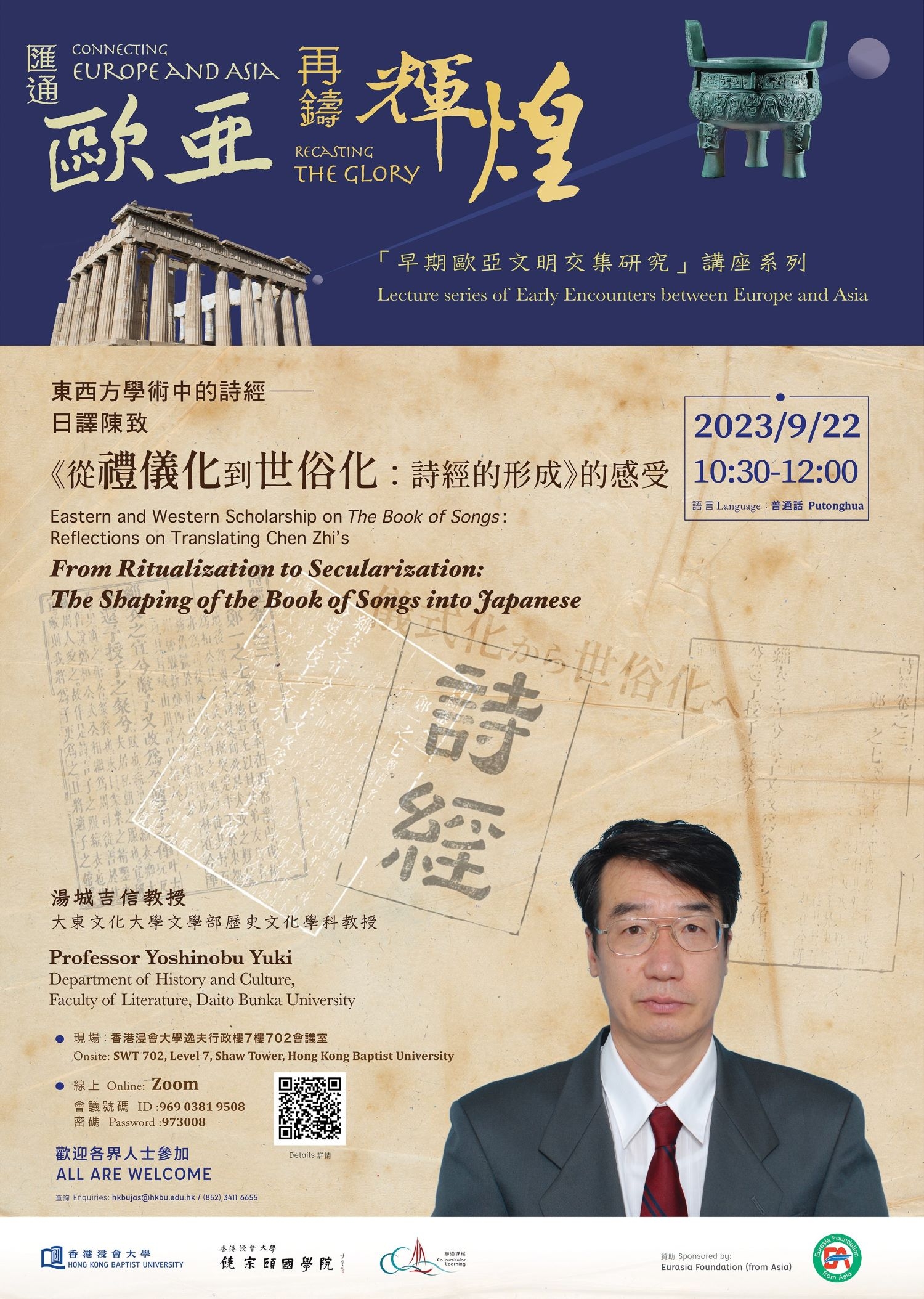
Connecting Europe and Asia, Recasting the Glory: Lecture series of Early Encounters between Europe and Asia
Lecture 2: Eastern and Western Scholarship on The Book of Songs: Reflections on Translating Chen Zhi’s From Ritualization to Secularization: The Shaping of the Book of Songs into Japanese
2023/9/22 │ 10:30 –12:00
Professor Yoshinobu Yuki
Department of History and Culture, Faculty of Literature, Daito Bunka University
- Abstract: Professor Chen Zhi’s From Ritualization to Secularization: The Shaping of the Book of Songs takes palaeography and linguistics as its starting points and draws in focus on musical archaeology and ethnomusicology. It makes fresh explanation of the multi-faceted origins and historical evolution of The Book of Songs in all their aspects. The compilation of The Book of Songs stems from conflict and compromise between Shang and Zhou culture, which experienced a complex and lengthy journey from ritualization to secularization and from standardization to regionalization.
Taking inspiration from the process of translating from Chinese into Japanese, Professor Yoshinobu Yuki, in addition to introducing how to deal with issues including those of cultural adaption, will also discuss how historically the Japanese have treated Chinese culture and characters, and in the future, how matters of cultural exchange between the Japanese and Chinese could be addressed.
- Language: Putonghua
- Summary(Recorded by Guan Jinglin)
In this lecture, Yoshinobu Yuki shared with his audience the experience of translating Professor Chen Zhi’s The Shaping of the Book of Songs: From Ritualization to Secularization into Japanese and the problems that he had faced.
The translation itself began in February 2021 and was published in June 2023, so the whole process took more than two years. Professors Yuasa Kunihiro and Yoshinobu Yuki and members of their team made comparisons between the English edition and those in full-form and simplified characters and taking comprehensive consideration of the linguistic characteristics of Chinese and Japanese, they succeeded in solving many difficulties pertaining to translation and finally accomplished the translation of the Japanese edition.
Professor Yoshinobu discussed issues relating to this translation by concentrating mainly on the dual aspects of features other than the written characters and matters pertaining to the characters themselves. Features other than the written characters converge on two principal areas. The first of these is variation between the punctuation employed; for example, the functions of the two types of comma ‘ , ’ and ‘ 、’ are different in Japanese and Chinese, and adjustment of these is a matter to which great attention should be paid during the process of translation. The second is the citation of ancient text. Chinese, English, and Japanese are all extremely different in this respect, and a Japanese edition should naturally follow Japanese conventions, furnishing the reader with a succession of the original Chinese followed by an explanatory reading of the text (i.e. kunyomi of the Chinese text), an explanation of the text in Japanese (i.e. kunyomi in Japanese), and a translation into modern Japanese, and only in this way will a Japanese reader be able to understand clearly how to read an ancient text and comprehend its significance. Regarding issues related to Chinese characters, the most important aspect in this context is to pay attention to subtle differences between simplified and full-form characters, Chinese and Japanese lexical items that carry different meanings, and technical terminology, all within a framework of aiming to produce an accurate translation.
In the last part of the lecture, Professor Yoshinobu surveyed his translation from a historical perspective and discussed matters of interaction and evolution in respect of Chinese characters in both Chinese and Japanese culture. In ancient times, Chinese characters were transmitted into Japan, and they brought in their wake religious and philosophical thought that included Buddhism and the neo-Confucianism of Zhu Xi and his school. In recent times, China has also imbibed from Japan the nomenclature of Western European scholarship, the technical terminology of the social sciences, and other facets of the vocabulary of the modernisation of Chinese characters. These matters embody the universality of Chinese characters that transcends epoch and region. Professor Yoshinobu considers that although China and Japan had formerly employed a common character set, both countries are currently proceeding along their own pathway in this respect. He reminded us to take stock and reflect on whether the two states might not resume their cultural interaction of earlier times.
- Lecture video
HKBUTube
Bilibili
This lecture series is sponsored by Eurasia Foundation (from Asia).